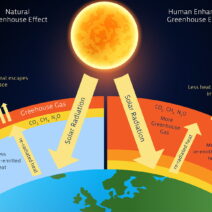Germany’s weather intricately weaves a tapestry of diverse climatic influences that shape not only the landscape but also the culture and lifestyle of its inhabitants. Spanning a multitude of geographic regions, Germany experiences a blend of oceanic, continental, and even alpine climates. This variability beckons exploration and understanding, as it plays a significant role in agriculture, tourism, and even the everyday lives of citizens.
To begin with, it is essential to comprehend the broader climatic zones within Germany. The northern regions, bordering the North Sea and the Baltic Sea, are characterized by a temperate maritime climate. This translates to mild summers and relatively cool winters, underscored by decent precipitation throughout the year. As one moves southward, the climate shifts noticeably. In regions such as Bavaria, the weather adopts a more continental flair with hotter summers and colder winters than its northern counterpart. Additionally, areas near the Alps experience a more pronounced alpine environment, marked by snowy peaks and a cooler, distinct winter season.
Temperature variations are a hallmark of Germany’s complex climate. The average annual temperature in Germany hovers around 8 to 10 degrees Celsius (46 to 50 degrees Fahrenheit), but fluctuations can be striking. In the summer months, particularly July and August, temperatures can surge to a balmy 25 to 30 degrees Celsius (77 to 86 degrees Fahrenheit) in southern regions, offering ideal conditions for outdoor activities, while northern parts remain a few degrees cooler. Conversely, winter can bring frigid conditions, particularly in January, where temperatures often dip below freezing — especially in elevated regions like the Erzgebirge mountains.
Precipitation patterns throughout Germany also warrant attention. Rainfall is relatively evenly distributed across the months, though the late spring and summer months tend to witness slightly increased levels due to thunderstorm activity. The average annual precipitation ranges from about 600 millimeters (23.6 inches) in some lower-lying areas to over 2,000 millimeters (78.7 inches) in the mountains of Bavaria. This variation creates diverse ecosystems, from lush forests and vineyards to fertile agricultural land, showcasing the adaptability of both nature and farming practices to the climatic nuances.
An exceptional feature of Germany’s climate is its stark seasonal contrasts. Each season bestows its own unique charm, painting the landscape in vibrant colors. Spring emerges gently, gradually shaking off the winter chill, as crocuses and daffodils blossom, signaling renewal and hope. Summer, with its extended daylight hours, invites a plethora of outdoor festivities, from vibrant beer gardens to grand music festivals. Autumn ushers in a magnificent display of foliage, as trees don shades of gold and crimson, while winter casts a serene blanket of snow, inviting ski enthusiasts and holiday celebrations to flourish.
The interplay between geographical formations and climate creates microclimates within Germany that are both fascinating and pivotal. For instance, in the Rhine Valley, the convergence of the Rhine River and favorable climatic conditions cultivates a renowned wine region, where vineyards thrive under optimal sunlight and climatic temperance. This not only underlines the intricate relationship between climate and agriculture but also highlights Germany’s commitment to maintaining its agricultural heritage amidst changing global climates.
Moreover, understanding Germany’s climate extends beyond mere curiosity; it carries profound implications for environmental policy and action. With climate change presenting a host of challenges — from increasing temperatures to unpredictable weather patterns — Germany has emerged as a leader in sustainable practices and renewable energy initiatives. The nation’s commitment to an ambitious energy transition plan known as the “Energiewende” seeks to mitigate the effects of climate change while promoting ecological sustainability. Wind, solar, and hydroelectric power are being harnessed at remarkable scales to reduce dependence on fossil fuels and combat greenhouse gas emissions.
Tourism in Germany is inexorably linked to its climatic conditions. Regions like the Bavarian Alps are not only picturesque but also attract winter sports enthusiasts year-round. Conversely, cities such as Berlin and Munich thrive during the summer months, drawing visitors eager to explore historic landmarks and indulge in local culinary delights. Thus, understanding weather patterns is essential for both the tourism sector and potential travelers alike, allowing for well-informed decisions regarding travel itineraries and activities.
Moreover, climate variability poses a myriad of risks to vulnerable ecosystems, wildlife, and human populations across Germany. Certain species are on the brink of extinction due to habitat loss and changing climatic conditions. In response, numerous conservation initiatives are underway to preserve biodiversity and restore damaged ecosystems. These endeavors illustrate not only a commitment to environmental responsibility but also an acknowledgment of humanity’s role in stewarding the planet.
In conclusion, Germany’s climate is a multifaceted subject deserving of exploration and understanding. It serves as a bridge between nature and people’s lives, influencing everything from agriculture to tourism, and shaping the social fabric of communities. The diverse climatic zones and seasonal changes offer significant insight into the remarkable relationship between the environment and human activities. As climate change continues to pose challenges globally, recognizing and adapting to Germany’s unique climate will be pivotal in forging a sustainable future. This exploration of Germany’s weather is not only an invitation to delve deeper into its climatic intricacies but also an implicit call to action in pursuit of ecological stewardship and resilience.


